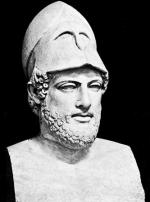|
This section contains 6,221 words (approx. 21 pages at 300 words per page) |

|
SOURCE: Meszaros, Patricia K. “Pericles: Shakespeare's Divine Musical Comedy.” In Shakespeare and the Arts, edited by Cecile Williamson Cary and Henry S. Limouze, pp. 3-20. Washington, D.C.: University Press of America, 1982.
In the following essay, originally delivered as a lecture in 1981, Meszaros explores the significance of music in Pericles.
In The Shakespearian Tempest (1932) and The Crown of Life (1947), G. Wilson Knight organized his interpretations of Shakespeare's last plays around their recurring, dichotomous images of tempests and music—the former representing ultimate disorder and chaos, the latter universal harmony. Knight's reading of the romances as immortality myths in which restoration and reconciliation are symbolized by the final victory of music over tempest has informed nearly all subsequent criticism, and although John Hollander has rightly pointed out that Knight's “insistence on symbolic music ignores conventions of musical imagery and exegesis in Renaissance literature,”1 it is nevertheless true that Knight's...
|
This section contains 6,221 words (approx. 21 pages at 300 words per page) |

|


